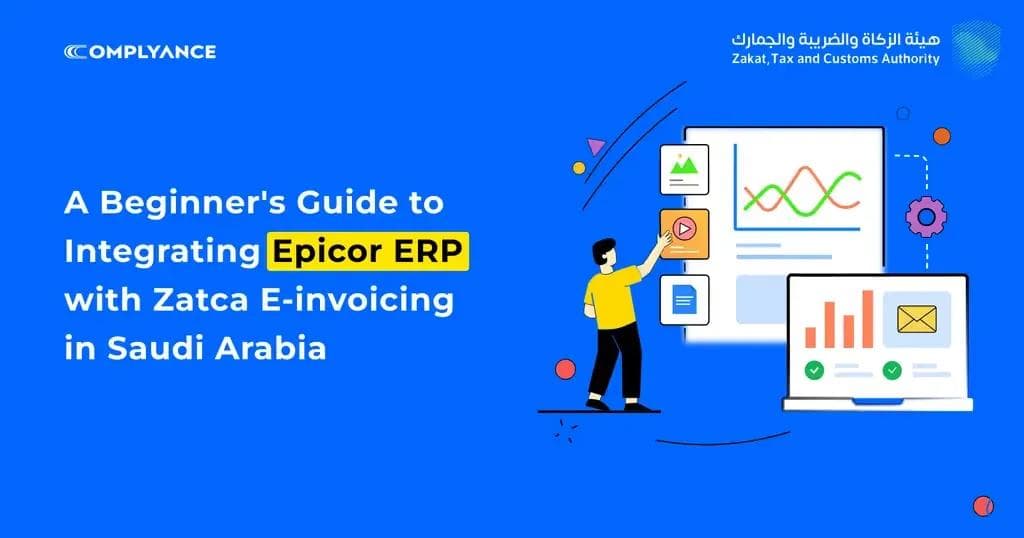How to get your Epicor ERP Zatca E-Invoicing compliant
Struggling to make your Epicor ERP system compliant with Zatca E-Invoicing? This guide will walk you through the process for effortless compliance.

Table of Contents
How to get your Epicor ERP Zatca E-Invoicing compliant
Today We will explore the integration of Epicor ERP Kinetic Framework with Zatca E-Invoicing in Saudi Arabia. Whether you are a business owner, an ERP specialist, or a tech enthusiast, this guide will provide valuable insights into streamlining your operations and ensuring compliance. Let's embark on this enlightening journey together!
Getting to Know the Players: Epicor ERP, Zatca and a Technical expert.
To begin, let's familiarize ourselves with the key players involved in the integration process: Epicor ERP and Zatca.
Epicor ERP is a comprehensive ERP solution that offers real-time insights, efficiency, and scalability for businesses. Its flexible and industry-specific functionalities make it highly appreciated in various sectors, especially for Manufacturing sectors.
On the other hand, Zatca is the regulatory body in Saudi Arabia governing e-invoicing. With recent regulations mandating businesses to integrate their ERP systems with Zatca, compliance has become a necessity.
and finally, a Technical Expert who can understand the regulations and try to cater to your current business operations and device a technical plan in terms of ERP to suite your specific needs so that your business doesn’t get affected which ensures a smooth transition.
Understanding the Need for Integration
Before we delve into the integration process, it's important to understand why integrating Epicor ERP with Zatca is the best way to get your business e-invoicing compliant.
- Compliance: Adhering to Zatca regulations is crucial for businesses in Saudi Arabia. Integration ensures legal compliance, mitigating potential legal issues down the line.
- Efficiency: Integrating your ERP system with Zatca e-invoicing streamlines your business operations. It enables real-time data exchange and eliminates manual processes, resulting in improved efficiency and accuracy.
- Convenience: As Epicor ERP is the software where your business generates invoice and it would be the best place to integrate to zatca by building an internal application in Kinetic AppStudio which consumes Zatca’s APIs directly or indirectly and gets your business compliant.
Ways of integrating External APIs
there are mainly three ways to Integrate Epicor ERP,
- Building an internal application using Kinetic App studio which consumes external APIs (Preferred way, and we have provided a brief on Kinetic Framework)
- Integrating using Jitterbit is another option
- Directly connecting to the underlying MYSQL DB (which can be used as a last resort)
Epicor Kinetic Framework.
The Epicor ERP Kinetic Framework is a powerful technology that enables the integration with Zatca E-Invoicing. Let's discover how this framework functions from a technical perspective.
Incorporating Industry Standard Technologies
The Kinetic Framework leverages universally accepted technologies, frameworks, and UI components. By utilizing trusted and current technologies, it establishes a reliable, secure, and user-friendly platform for integration.
Kinetic Framework Layers
Within Epicor, several types of Kinetic applications are being created. These include Kinetic Inspired Applications (CSS Styled), Kinetic Standard Applications (hand-coded), and App Studio Applications (metadata driven). The choice of the Kinetic application type depends on the platform's technology position and the requirements of the specific application.
By leveraging these features and capabilities, developers can create robust, user-friendly applications that align with the Kinetic Design system and Epicor's best practices.
Integration Process: A Step-By-Step Guide
Now, let's break down the integration process into actionable steps:
Step 1: Analyzing Your Current System
The first step is to analyze your existing ERP system thoroughly. This involves understanding its architecture, your business requirements, and the operational workflow. By gaining a deep understanding of your system, you can design a more effective integration process.
Step 2: Consultation with Epicor ERP Implementors
Once you have a clear understanding of your current system, it's time to seek guidance from Epicor ERP experts. These professionals have in-depth knowledge of the Epicor ERP Kinetic Framework and can guide you through specific processes and configurations required for the integration or they can even help you directly by using any of the above mentioned ways.
Step 3: Integration and Testing
With the guidance of experts, you can proceed with the integration process. It involves mapping the data from your ERP system to the e-invoice structure of Zatca, ensuring seamless communication between the two systems. After integration, comprehensive testing should be conducted to verify that data flow correctly from the ERP system to Zatca's platform.
Step 4: Training and Support
Once the integration is complete, it is crucial to provide training to your staff. They should be well-equipped to handle the new system and troubleshoot any potential issues that may arise. Ongoing support should also be in place to address any concerns or queries that may arise post-integration.
The problems of a business Directly Integrating with Zatca
Even though Zatca have their developer sandbox ready for the developers of a business to test and move their business to production and get Zatca e-invoicing compliant, it comes with its own issues
- you wouldn’t be able to validate in real-time before sending it to Zatca for clearance(B2B) or reporting (B2C)
- Zatca only accepts XML in their API request and response
- there are a few fields in the invoice that requires blockchain capabilities
- there are no failure mechanisms for you to fallback and directly getting rejected by Zatca is the only option.
- Consolidating your business operations and getting it e-invoicing compliant on your own is tedious and cumbersome(and a bit boring too).
So, what we would suggest is to get a partner on board (we are just a click away) and get your business Zatca E-Invoicing Compliant.
Conclusion
Integrating Epicor ERP Kinetic Framework with Zatca E-Invoicing in Saudi Arabia is a crucial step for businesses to ensure compliance and streamline operations. By following the step-by-step guide outlined in this blog post, you can successfully integrate these systems and reap the benefits of real-time data exchange and automation. The Epicor ERP Kinetic Framework, with its industry-standard technologies and versatile deployment options, provides a solid foundation for this integration.
Remember, compliance and efficiency are key drivers for success in today's business landscape. Stay ahead of the curve by embracing ERP integration and harnessing the power of technology to drive your business forward.
Related posts
Frequently Asked Questions
E-invoicing, also known as electronic invoicing, is a form of billing that is presented to the buyer in an electronic format via a predefined structured data exchange. This electronic document exchange between buyer and seller can help streamline and automate portions of the accounts payable process.
Subscribe to our Newsletter
Get the latest compliance updates, e-invoicing news, and expert tips delivered to your inbox.
ABOUT COMPLYANCE
Empowering businesses to automate e-invoicing and stay compliant in 100+ countries. Our platform simplifies regulatory complexity for enterprises and fast-growing companies.
Go Live in a Week with Developer-Friendly Global E-Invoicing Platform
Complyance makes it easy for your IT/dev team to integrate once and automate E-Invoicing across 100+ countries. Built for fast deployment, field-level validation, and indirect tax accuracy—no delays, no rework.



